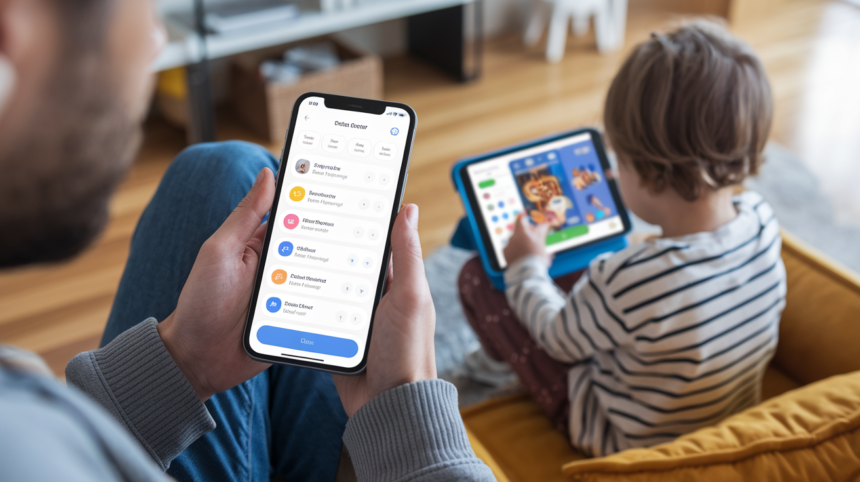Imagine this: You’re sipping coffee in the kitchen, and your kids are playing quietly in their rooms. You feel a little uneasy. Are they safe online? Could someone be trying to reach them? Is their screen time healthy? You’re not alone. Every parent feels that flicker of worry.
That’s exactly why understanding the top strategies with smart technology to protect children is not just important it’s essential in today’s world.
Smart devices are everywhere now in our pockets, bedrooms, even classrooms. While they open incredible doors for learning and fun, they also bring real risks you can’t afford to ignore. But here’s the good news: Smart technology isn’t just the problem. It’s a huge part of the solution if you know how to use it right.
Let’s dive deep into real strategies, backed by real-world experience, so you can breathe easier, knowing you’re doing everything possible to protect your kids.
Why Protecting Children with Smart Technology Matters More Than Ever
There’s no sugarcoating it kids today are growing up in a digital jungle.
- Nearly 60% of teenagers have been approached by strangers online.
- About 70% of kids have stumbled upon inappropriate content by accident.
- Cyberbullying affects 1 in 3 children globally.
(Stats from Pew Research and UNICEF, 2024.)
These aren’t just scary numbers they’re daily realities for millions of families. Without solid strategies, you’re basically letting your kids wander unsupervised in a city filled with strangers.
Smart technology can help you monitor, educate, and even empower your kids to make better choices if you know the best moves to make. That’s exactly what we’re covering today.
Quick Overview: What You’ll Learn Here
- The top strategies with smart technology to protect children
- Common mistakes parents make (and how to avoid them)
- Must-know myths about digital safety
- How to teach your kids to protect themselves
- Tools, apps, and real-world examples you can use starting today
Let’s get rolling.
1. Start with Parental Control Software But Use It Right
If you think parental control apps are “spying,” think again.
Used smartly, they’re your first defense line.
Some of the best parental control apps today:
| App | Best Feature | Why Parents Love It |
|---|---|---|
| Bark | Monitors texts, emails, and apps | Alerts you to bullying, predators, and threats |
| Qustodio | Screen time control + GPS tracking | Great balance of privacy and safety |
| Net Nanny | Web filtering + real-time alerts | Very customizable for different age groups |
Pro Tip: Set expectations first.
Tell your kids upfront that monitoring isn’t about punishment it’s about trust and protection.
Why This Matters
Imagine you had a car without brakes. That’s what giving a kid a phone without supervision feels like.
Parental controls = brakes + seatbelt + airbags.
2. Smart Devices for Smart Protection
Tech can be your biggest ally if you choose wisely.
Here’s what to consider:
- Smartwatches like the Verizon GizmoWatch let you track your child’s location, call them, and set safe zones.
- WiFi routers like Gryphon and Eero Secure filter inappropriate content straight at the source.
- Smart speakers (Amazon Echo, Google Nest) can set homework timers, answer safe questions, and even control screen time across devices.
Real-life example:
When my friend Laura gave her 9-year-old a smartwatch, she could check if he made it home from school without constant texting. Both felt safer and freer.
3. Teach Digital Literacy Early (Way Earlier Than You Think)
One of the top strategies with smart technology to protect children is education.
Not rules. Not fear. Knowledge.
Even a 5-year-old can learn:
- What personal information is
- Why you don’t talk to strangers online
- How to spot a “too good to be true” scam
Simple Script Example:
“If someone online says ‘Keep this secret,’ it’s ALWAYS a trick. Always tell me.”
Use smart tech to teach:
- Google’s Interland game teaches online safety through fun adventures
- YouTube Kids (properly monitored) offers educational videos about internet smarts
4. Set Boundaries and Stick to Them Like Glue
Rules without follow-through are just… suggestions.
Here’s a simple but powerful setup:
- No devices at dinner
- Screen-free bedrooms at night
- One hour of tech-free outdoor time daily
- App download permission must go through you first
Tech Tools to Help:
- Screen Time (iOS) or Family Link (Android) apps set daily limits
- Router-based timers (like Circle with Disney) automatically pause WiFi during off-hours
Pro Tip:
Involve your kids when making the rules. They’ll follow them more willingly if they help create them.
5. Stay One Step Ahead of Tech Trends (It’s Easier Than You Think)
Apps, games, trends they move fast.
Luckily, you don’t have to be a tech wizard to keep up.
Here’s how:
- Subscribe to Common Sense Media for trusted reviews
- Check Reddit parenting forums (like r/Parenting or r/DigitalParenting)
- Set Google Alerts for keywords like “new apps for kids”
The top strategies with smart technology to protect children always include being proactive, not reactive.
6. Talk About the Hard Stuff (Don’t Wait Until It’s Too Late)
It’s uncomfortable, sure. But kids need open conversations about:
- Online predators
- Cyberbullying
- Inappropriate content
Use smart tech like:
- ReThink App: It teaches kids to think twice before posting something hurtful.
- Anonymous reporting tools at school (many schools use apps now)
Conversation Starters:
- “Have you ever seen something online that made you uncomfortable?”
- “What would you do if a stranger asked to chat with you?”
Tip: Keep it casual. Talk in the car. While doing chores. Not face-to-face sit-down “serious talks” kids clam up that way.
7. Empower Kids to Make Smart Choices
Helicopter parenting doesn’t work online. Teaching decision-making does.
Empower by practicing:
- Role-playing “what-if” scenarios
- Letting them make small online choices with guidance
- Giving praise for good digital citizenship
8. Beware of These Common Mistakes
Even well-meaning parents trip up sometimes.
Big no-nos:
Over-blocking everything (leads to secret accounts)
Ignoring conversations about “small” apps like Roblox or Discord
Forgetting that kids outsmart tech if they really want to
Stay flexible. Update your strategies as your child grows.
9. Top Myths About Smart Tech Safety (Debunked)
Let’s bust a few myths:
| Myth | Truth |
|---|---|
| “My kid is too young to be targeted.” | Predators target kids as young as 5. |
| “Only bad parents need monitoring apps.” | Smart parents use every tool available. |
| “Talking about dangers will scare my kid.” | Silence leaves them vulnerable. Knowledge = confidence. |
10. Real-World Tips from Experienced Parents
Nothing beats advice from the trenches.
Ashley, mom of 3: “We set up an ‘online contract’ with our kids. Clear rules. They signed it. Total game-changer.”
Carlos, dad of 2: “I use screen mirroring apps to randomly check devices. No drama just part of the deal.”
Priya, single mom: “We have a ‘tech talk’ night once a month. Pizza + safety chats. Keeps it fun.”
Wrapping It All Up: Smart Tech, Smarter Parents
Using the top strategies with smart technology to protect children isn’t about fear.
It’s about giving your kids the freedom to explore, learn, and grow with you by their side.
When you blend the right tools, solid boundaries, and open conversations, you create a digital safety net that’s flexible, strong, and real.
Because at the end of the day, it’s not just about guarding their devices.
It’s about guarding their trust, confidence, and future.
Quick Summary: Action Plan for Parents
| Step | What to Do |
|---|---|
| 1 | Install parental control software with open discussion |
| 2 | Pick smart devices designed for safety |
| 3 | Teach digital literacy early |
| 4 | Set screen-time rules together |
| 5 | Stay informed on new tech trends |
| 6 | Have honest talks about online risks |
| 7 | Empower, don’t just control |
| 8 | Learn from real parent stories |
FAQ
(Add these in collapsible FAQ blocks if your CMS supports it for better engagement and SEO!)
What are the best parental control apps to protect children?
Some top-rated options include Bark, Qustodio, and Net Nanny. These apps monitor texts, apps, web usage, and even detect signs of bullying or threats.
How early should kids learn about online safety?
Experts recommend starting digital literacy as early as age 5. Using games, apps, and real-world examples makes the lessons fun and effective.
How can smartwatches help protect kids?
Smartwatches like the GizmoWatch allow GPS tracking, safe calling, and location alerts giving both parents and kids more peace of mind.
What rules should parents set for screen time?
Simple but effective rules include:
- No devices at dinner
- No screens in bedrooms at night
- Daily offline time outdoors
- Apps require parental approval
Can technology fully protect children online?
Technology provides amazing support, but open communication with your child is still the strongest shield against online risks.






